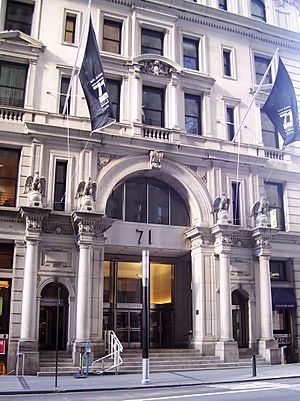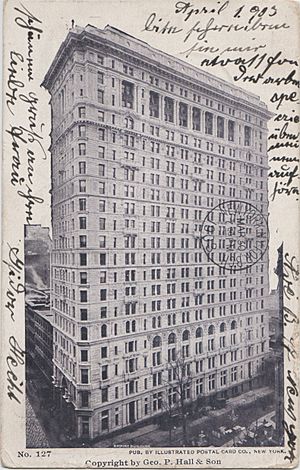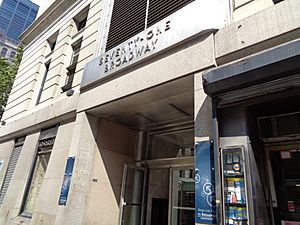Empire Building (Manhattan) facts for kids
|
Empire Building
|
|
|
U.S. Historic district
Contributing property |
|

(1898)
|
|
| Location | 71 Broadway, Manhattan, New York |
|---|---|
| Built | 1895–1898 |
| Architect | Kimball & Thompson |
| Architectural style | Classical Revival |
| Part of | Wall Street Historic District (ID07000063) |
| NRHP reference No. | 83004643 |
Quick facts for kids Significant dates |
|
| Designated {{{NRHP_TYPE}}} | August 28, 1998 |
The Empire Building is a tall office building located at 71 Broadway in the Financial District of Manhattan, New York City. It stands on the corner of Rector Street. The building was designed by Kimball & Thompson in a style called Classical Revival. It was built between 1897 and 1898 by Marc Eidlitz & Son.
This building has 21 floors above ground, plus a basement level that faces Trinity Place. It is about 293 feet (89 meters) tall. The Empire Building is one of the first skyscrapers ever built using a special foundation method called pneumatic caissons. It is also one of the oldest buildings of its kind still standing today.
The building's outside walls are made of gray granite at the bottom and white granite on the upper floors. Inside, it has a strong steel frame structure. The Empire Building was home to the United States Steel Corporation for many years, from 1901 to 1976. Later, in 1997, the building was changed into apartments. It was recognized as a city landmark in 1996 and added to the National Register of Historic Places in 1998.
Contents
Location and Surroundings
The Empire Building is on a plot of land that is 78 feet (24 meters) wide along Broadway. It stretches 223 feet (68 meters) along Rector Street and 50 feet (15 meters) on Trinity Place. The total area of the building's base is about 14,000 square feet (1,300 square meters).
Next to the building on Rector Street is the churchyard of Trinity Church. This open space gives the Empire Building clear views. To the south, you'll find 65 Broadway, which used to be the main office for the American Express company.
It's easy to get to the Empire Building by subway. There are entrances to New York City Subway stations right outside the building. You can find stairs to the Wall Street station (Lexington Avenue Line) on either side of the main entrance on Broadway. An entrance to the Rector Street station (Broadway Line) is located on Trinity Place.
Building Design and Features
The Empire Building was designed by the architectural team of Kimball & Thompson. They used the Classical Revival style, which looks back to ancient Greek and Roman designs. Charles Sooysmith was the engineer for the building's foundation. Even though the main entrance is on Broadway, there are also entrances on Trinity Place.
The building was originally planned to have 20 stories. Later, an extra 21st story was added, along with a basement. The building's outside walls go straight up from the street. There are two open spaces, called light courts, on the south side of the building. These help bring natural light into the offices. The offices were designed to face north, towards Trinity Church.
What the Outside Looks Like
The outside of the Empire Building is divided into three main parts, much like a classic column. These parts are a "base" (the bottom four floors), a "shaft" (the middle twelve floors), and a "capital" (the top four floors). This style was very popular for tall buildings built around the late 1800s and early 1900s.
The original plan was to use terracotta for the outside, but the Potter family, who built the Empire Building, decided to use granite instead. They felt granite looked "more suitable" for such an important building.
The Base
The bottom four floors, or "base," are made of shiny gray granite. Because the ground slopes down from Broadway to Trinity Place, the basement on Trinity Place has full-height storefronts.
The main entrance on Broadway looks like a triumphal arch. It has a large archway with three sets of steel doors. On either side of this main arch are two smaller arches that lead to shops on the first floor. Two pairs of granite columns stand next to the triumphal arch, each topped with an eagle on a globe. This entrance was updated in the late 1930s. It now has a stainless-steel sign above the doors that says "71 Broadway 71."
On the corner of Broadway and Rector Street, there used to be another entrance. Along Rector Street, the base of the building is split into three parts. The third and fourth floors on Rector Street have an arcade with tall, flat columns called pilasters.
The Middle and Top Floors
The "shaft" of the building is made up of twelve floors of white granite. The 5th floor acts as a connection between the base and the upper floors. The rest of the shaft has horizontal bands that stretch across the building. The 9th and 13th floors have vertical pilasters and arched windows, which are different from the rectangular windows on other floors. Some floors, like the 7th, 11th, and 15th, have balconies. There is a decorative ledge, called a cornice, above the 16th floor.
The "capital" is the top four stories. It features open areas called loggias on the 18th and 19th floors. These loggias have pairs of columns that form a colonnade. There are also decorative panels. The 21st story was added between 1928 and 1930. On the south side of the 21st floor, there is a small tower made of terracotta. This tower holds the machinery for the elevators.
Inside the Building
The foundation of the Empire Building was designed by Charles Sooysmith. It uses 23 special concrete structures called pneumatic caissons that go 23 feet (7 meters) deep into the solid rock below. These caissons helped to avoid disturbing other buildings during construction. The Empire Building was one of the first skyscrapers to use this method, following the example of the nearby American Surety Building.
The building has a total floor area of about 300,000 square feet (27,871 square meters). Because of the shape of the land, none of the building's sides are perfectly equal or parallel.
In 1997, the Empire Building was changed into a residential building. It now has 238 apartments, ranging from small studio apartments to larger one- and two-bedroom units. Even though much of the inside has been updated, one of the original staircases on the western side of the building is still there. This staircase has an iron railing with decorations of dolphins and Neptune's scepter, and marble steps.
The building originally had 10 elevators. Nine were for passengers and one was a freight elevator that could carry heavy loads. These elevators had a special safety feature: the bottom 50 feet (15 meters) of each elevator shaft narrowed slightly. This created an "air cushion" that would slow down the elevator if it ever fell, using air pressure to protect passengers. This safety feature was tested by dropping an elevator cab with eggs and light bulbs inside. Even after falling at 82 miles per hour (132 km/h), the eggs and light bulbs were not broken!
History of the Empire Building
Early Days and Construction
The land where the Empire Building stands was once owned by Trinity Church and the German Lutheran Church. In the late 1700s, there was an inn on the corner of Rector Street and Broadway. Later, a church was built on the site.
In 1859, a six-story brownstone office building was constructed at 71 Broadway. This building became known as the Empire Building or Arcade Building. It was called the Arcade Building because there was a public walkway, or arcade, next to it. This arcade connected Broadway to the old Sixth Avenue elevated train's Rector Street station.
By the 1880s, the land became very valuable. In 1884, a politician and real estate developer named Orlando B. Potter bought the building. Sadly, Potter passed away in 1894 before the current building could be constructed. His children took over his property and decided to build the new Empire Building.
Construction on the new building began on June 1, 1897. During the digging, workers found a cornerstone from the old Grace Church, as well as bones and old tombstones. The arcade from the old building was kept and included in the new design. The outside of the building was finished on April 19, 1898, and the first businesses moved in soon after. When it was completed, the Empire Building was one of the tallest buildings in New York City by the number of floors.
Usage Over Time
By 1900, more than 3,000 people worked in the Empire Building. One of the first and most important tenants was the U.S. Steel Corporation, which was founded right there in 1901. The architects, Kimball & Thompson, also had offices in the building.
In 1919, the U.S. Steel Corporation bought the building from the Potter family for about $5 million. This was a very large sale for a private property in New York City at the time. It showed that New York was becoming a major center for the steel industry.
Between 1928 and 1930, an extra 21st story was added to the building. The original top part of the building was removed, and the new floor and an elevator machine room were built. In 1937, more big changes were made to the Empire Building. The main entrance on Broadway and the Trinity Place entrance were updated to an Art Deco style. The connection to the Sixth Avenue elevated train station was removed.
U.S. Steel sold the building in 1973, but their headquarters remained there until 1976. They continued to have offices in the building until the mid-1980s.
In 1997, the Empire Building was changed into 237 apartments by the World-Wide Group. This renovation cost $40 million. The apartments quickly became popular. At one point, a famous politician and economist named Dominique Strauss-Kahn lived in the building. During his time there, the Empire Building received a lot of attention from the media and became a "new tourist hot spot."
See also
 In Spanish: Empire Building para niños
In Spanish: Empire Building para niños




